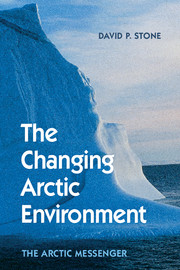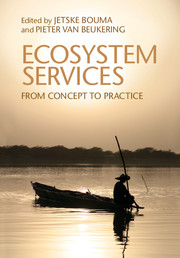Refine listing
Actions for selected content:
2285 results in Ebooks in ecology and environment
Appendix V - The Concept of Commitment
-
- Book:
- The Changing Arctic Environment
- Published online:
- 05 February 2015
- Print publication:
- 16 February 2015, pp 320-322
-
- Chapter
- Export citation
2 - The Arctic Messenger
- from PART I - THE CHANGING ARCTIC
-
- Book:
- The Changing Arctic Environment
- Published online:
- 05 February 2015
- Print publication:
- 16 February 2015, pp 11-20
-
- Chapter
- Export citation
11 - Thoughts on Education, the Training of Arctic Scientists, and Arctic Research
- from PART IV - WHAT DOES ALL THIS MEAN?
-
- Book:
- The Changing Arctic Environment
- Published online:
- 05 February 2015
- Print publication:
- 16 February 2015, pp 267-278
-
- Chapter
- Export citation
Appendix III - Some Geophysical Background Notes Related to Climate and Weather
-
- Book:
- The Changing Arctic Environment
- Published online:
- 05 February 2015
- Print publication:
- 16 February 2015, pp 314-317
-
- Chapter
- Export citation
7 - Stratospheric Ozone Depletion
- from PART III - WHAT IS THE PRESENT STATE OF KNOWLEDGE?
-
- Book:
- The Changing Arctic Environment
- Published online:
- 05 February 2015
- Print publication:
- 16 February 2015, pp 85-105
-
- Chapter
- Export citation

The Changing Arctic Environment
- The Arctic Messenger
-
- Published online:
- 05 February 2015
- Print publication:
- 16 February 2015

Ecosystem Services
- From Concept to Practice
-
- Published online:
- 05 February 2015
- Print publication:
- 29 January 2015
3 - A traits-based approach to quantifying ecosystem services
- from Part II - Measuring ecosystem services
-
-
- Book:
- Ecosystem Services
- Published online:
- 05 February 2015
- Print publication:
- 29 January 2015, pp 40-64
-
- Chapter
- Export citation
2 - The role of biodiversity in the provision of ecosystem services
- from Part II - Measuring ecosystem services
-
-
- Book:
- Ecosystem Services
- Published online:
- 05 February 2015
- Print publication:
- 29 January 2015, pp 25-39
-
- Chapter
- Export citation
Frontmatter
-
- Book:
- Ecosystem Services
- Published online:
- 05 February 2015
- Print publication:
- 29 January 2015, pp i-iv
-
- Chapter
- Export citation
5 - Economic values of ecosystem services
- from Part III - Valuing ecosystem services
-
-
- Book:
- Ecosystem Services
- Published online:
- 05 February 2015
- Print publication:
- 29 January 2015, pp 89-107
-
- Chapter
- Export citation
Plate section
-
- Book:
- Ecosystem Services
- Published online:
- 05 February 2015
- Print publication:
- 29 January 2015, pp -
-
- Chapter
- Export citation
Part III - Valuing ecosystem services
-
- Book:
- Ecosystem Services
- Published online:
- 05 February 2015
- Print publication:
- 29 January 2015, pp 87-88
-
- Chapter
- Export citation
6 - Economic valuation methods for ecosystem services
- from Part III - Valuing ecosystem services
-
-
- Book:
- Ecosystem Services
- Published online:
- 05 February 2015
- Print publication:
- 29 January 2015, pp 108-131
-
- Chapter
- Export citation
11 - Public–private partnerships and the governance of ecosystem services
- from Part V - Governing ecosystem services
-
-
- Book:
- Ecosystem Services
- Published online:
- 05 February 2015
- Print publication:
- 29 January 2015, pp 230-249
-
- Chapter
- Export citation
Part IV - Paying for ecosystem services
-
- Book:
- Ecosystem Services
- Published online:
- 05 February 2015
- Print publication:
- 29 January 2015, pp 161-162
-
- Chapter
- Export citation
10 - Global governance of ecosystem services and related policy instruments
- from Part V - Governing ecosystem services
-
-
- Book:
- Ecosystem Services
- Published online:
- 05 February 2015
- Print publication:
- 29 January 2015, pp 201-229
-
- Chapter
- Export citation
Part V - Governing ecosystem services
-
- Book:
- Ecosystem Services
- Published online:
- 05 February 2015
- Print publication:
- 29 January 2015, pp 199-200
-
- Chapter
- Export citation
9 - Payments for ecosystem services
- from Part IV - Paying for ecosystem services
-
-
- Book:
- Ecosystem Services
- Published online:
- 05 February 2015
- Print publication:
- 29 January 2015, pp 183-198
-
- Chapter
- Export citation
Index
-
- Book:
- Ecosystem Services
- Published online:
- 05 February 2015
- Print publication:
- 29 January 2015, pp 264-267
-
- Chapter
- Export citation
